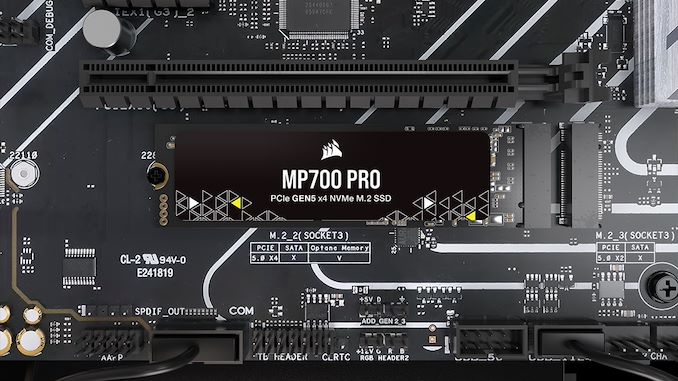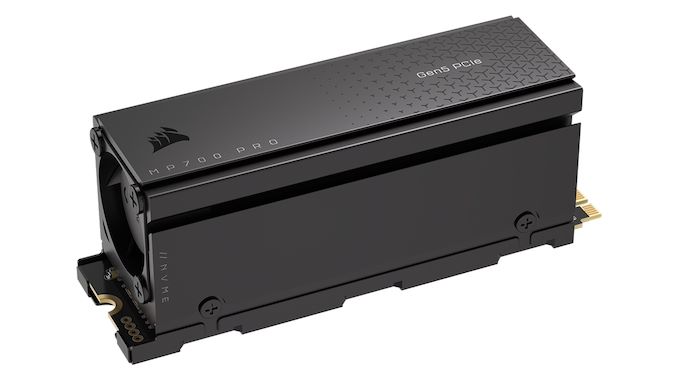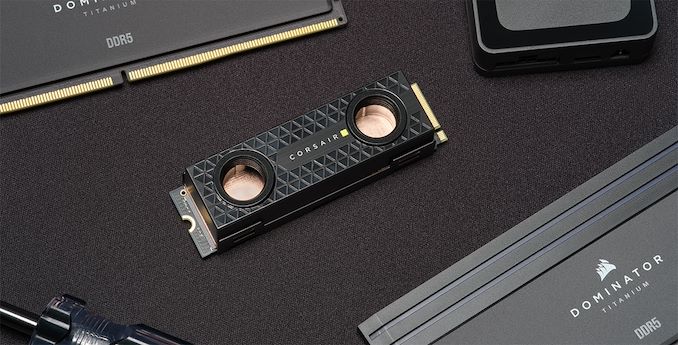Corsair Releases MP700 Pro SSDs: Up 12.4 GB/s With Three Cooling Options
by Anton Shilov on November 15, 2023 10:00 AM EST
Corsair has introduced its MP700 Pro-series solid-state drives with a PCIe 5.0 x4 interface that offer sequential read speed of up to 12.4 GB/s. The new high-end drive family offers a trio of cooling options, including active air cooling and liquid cooling. The SSDs will complement the company's MP700-series PCIe Gen5 drives and will offer a new level of performance for PC enthusiasts.
Corsair's MP700 Pro drives are based on Phison's PS5026-E26 controller as well what initial teardowns have discovered to be 232 layer Micron 3D TLC NAND memory. Compared to their earlier E26-based MP700 drive, Corsair has been able to increase the drive's maximum sequential read speed to 12.4 GB/s and maximum sequential write speed to 11.8 GB/s thanks to the use of faster NAND, which offers a higher 2000 MT/sec transfer rate (versus the original's 1600 MT/sec rate). In addition, the company increased random read speed to 1.5 million IOPS and random write speed to 1.6 million IOPS, which is comparable to speeds offered by enterprise-grade SSDs.
As far as capacity points are concerned, Corsair's MP700 Pro are currently available in 1 TB and 2 TB configurations, whereas 4 TB versions will be available sometimes in the future.
In addition to very high out-of-box performance, there is another selling point that Corsair's MP700 Pro drives have. They are available with three different cooling system to cater different PC form-factors and audiences. For high-performance laptops and compact desktops, Corsair offers MP700 Pro with a simplistic graphene heatspreader; for high-performance desktops, the company will offer these drives with an aluminum heatsink and a fan to ensure sufficient cooling and consistent performance even under high loads; whereas for owners of PCs with custom-built liquid cooling the company will offer a SSDs with a waterblock.
When the first M.2-2280 solid-state drives with a PCIe 5.0 x4 interface hit the market earlier this year, the majority of PCIe Gen5 SSDs topped out at a 10 GB/s sequential reads and writes since fast 3D NAND chips were in short supply. Now that 3D NAND with a 2000 MT/s interface is getting more widespread, Corsair and other manufacturers of SSDs are rolling out drives that can hit 12.4 GB/s read speeds.
In fact, Sabrent and some other makers are working on even faster SSDs with around 14 GB/s read speeds, so it is well possible that we are going to see a yet another 'sub-generation' PCIe Gen5 drives that will saturate a PCIe 4.0 x4 interface.
Source: Corsair













15 Comments
View All Comments
meacupla - Wednesday, November 15, 2023 - link
I was hoping to see an Airjet on one of these, rather than... well whatever those are.Reflex - Wednesday, November 15, 2023 - link
I don't believe those move nearly enough heat at this stage. i could be wrong but everything I've seen implies they are more for embedded devices at this time.meacupla - Wednesday, November 15, 2023 - link
They do 15W of cooling. How much power do these Gen5 drives consume?LordanSS - Wednesday, November 15, 2023 - link
Overclock3D.net did a review on these.On their temperature testing, with the fan on, 72C temperatures. And it's not even the hottest NVMe drive.
I know it's used in bursts for read/write but these things are getting way too hot.
TheinsanegamerN - Thursday, November 16, 2023 - link
But these things are maintaining boost speeds for extended periods of time with these heatsinks and people are whining about how theyre too hot.meacupla - Saturday, November 18, 2023 - link
NAND enjoys being hot, but the controller does not.AFAIK, the ideal spot is somewhere around 25~50c, but it's not like the controller throttles at 72c either. The heatsink solution works, it's just that 72c is a disappointing number for a monstrously large heatsink.
sonny73n - Sunday, November 19, 2023 - link
You don't care for efficiency but some of us does. You're also lack of knowledge and common sense. To make this short; excess heat is wasted energy and it's released INSIDE the case, affecting the temperatures of other components. I don't want to remember not to transfer large files while gaming.Makaveli - Monday, November 20, 2023 - link
Do you normally do large file transfers in the middle of your gaming session?Silver5urfer - Monday, November 20, 2023 - link
They max out at 15 min mark after that none of these PCIe SSDs maintain their PCIe gen speed all the way from 3.0, 4.0 and 5.0. They all drop to 1500MB/s after 960 Seconds, go and read Toms Hardware review on the sustained performance graphs. Only good drives perform consistently.Samsung are worst. Firmware problems, QC problems what not. 990 is also a pass. Better buy higher endurance NAND flash over the stupid perf numbers.
Reflex - Thursday, November 16, 2023 - link
Currently there are a number of challenges for this. first off, it's the wrong form factor to fit on a NVMe drive and still be compliant with most motherboards. Secondly, a single unit can only dispel around 5W of heat, which likely is not enough for these drives (the single system with one uses two on a 7W CPU).It's too early, and we have yet to see if they can scale or take other form factors.